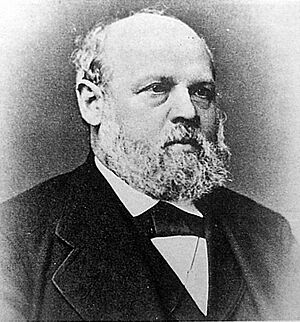Heinrich Geißler facts for kids
Quick facts for kids
Heinrich Geissler
|
|
|---|---|

Heinrich Geissler
|
|
| Born | 26 May 1814 Igelshieb, Thuringia, Saxe-Meiningen
|
| Died | 24 January 1879 (aged 64) |
| Nationality | German |
| Known for | Geissler tubes |
| Scientific career | |
| Fields | Physics |
Johann Heinrich Wilhelm Geißler (born May 26, 1814, in Igelshieb – died January 24, 1879) was a very talented German glassblower and physicist. He became famous for inventing the Geissler mercury vacuum pump in the mid-1850s. He also invented the Geissler tube in 1857. This special glass tube could glow when electricity passed through it. Both of these inventions were super important! They helped scientists later discover the electron, which is a tiny part of every atom.
Who Was Heinrich Geissler?
Heinrich Geissler came from a long line of skilled craftspeople. His family lived in the Thuringian Forest area of Germany and in Bohemia. He learned the art of glassblowing from a young age.
He worked at different German universities. Eventually, he settled down at the University of Bonn. There, a physicist named Julius Plücker asked him for help. Plücker needed a special device to remove air from a glass tube. This was a challenging task, but Geissler was the right person for the job. He opened his own workshop at the University of Bonn in 1852.
Amazing Inventions
Geissler's skills in glassblowing were truly amazing. He designed and built the first mercury vacuum pump. This pump could create a very good vacuum inside a glass tube. This meant almost all the air was removed.
In 1857, he invented the Geissler tube. This tube was made of glass and had a small amount of gas inside. When electricity was passed through the tube, the gas would glow with beautiful colors. These tubes were a big hit!
Lighting Up the World
Geissler tubes were very popular for entertainment in the 1800s. People loved watching the colorful glowing tubes. Over time, these tubes changed and improved. Around 1910, they led to the invention of commercial neon lighting. You still see neon lights today in signs and decorations!
Geissler's work also helped other scientists. The ideas from his discharge tubes led to the Crookes tube. With the Crookes tube, the electron was finally discovered in 1897. Later, in 1906, the technology evolved into the amplifying vacuum tube. Vacuum tubes were the basis for early electronics. They made long-distance communication possible, like radio and television.
Because of his important inventions, Heinrich Geissler was given an honorary doctorate in 1868. This was a special award to recognize his great contributions to science.


